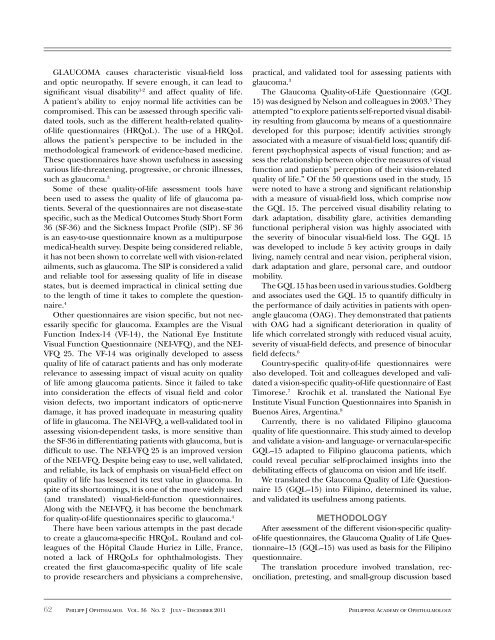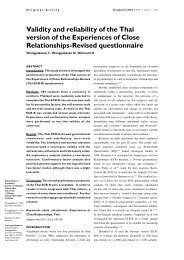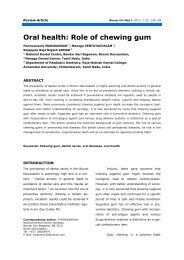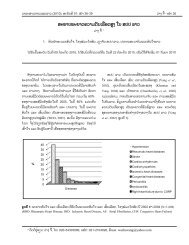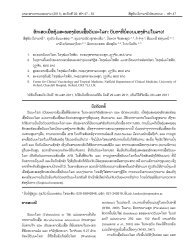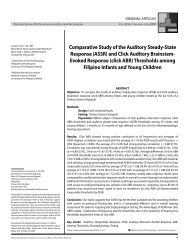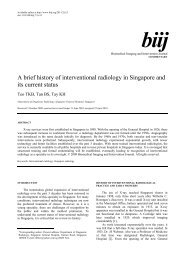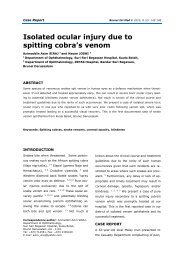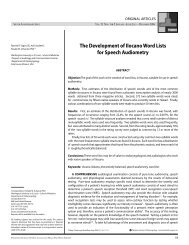Translation and validation of a Filipino version of the glaucoma ...
Translation and validation of a Filipino version of the glaucoma ...
Translation and validation of a Filipino version of the glaucoma ...
Create successful ePaper yourself
Turn your PDF publications into a flip-book with our unique Google optimized e-Paper software.
Glaucoma causes characteristic visual-field loss<strong>and</strong> optic neuropathy. If severe enough, it can lead tosignificant visual disability 1-2 <strong>and</strong> affect quality <strong>of</strong> life.A patient’s ability to enjoy normal life activities can becompromised. This can be assessed through specific validatedtools, such as <strong>the</strong> different health-related quality<strong>of</strong>-lifequestionnaires (HRQoL). The use <strong>of</strong> a HRQoLallows <strong>the</strong> patient’s perspective to be included in <strong>the</strong>methodological framework <strong>of</strong> evidence-based medicine.These questionnaires have shown usefulness in assessingvarious life-threatening, progressive, or chronic illnesses,such as <strong>glaucoma</strong>. 3Some <strong>of</strong> <strong>the</strong>se quality-<strong>of</strong>-life assessment tools havebeen used to assess <strong>the</strong> quality <strong>of</strong> life <strong>of</strong> <strong>glaucoma</strong> patients.Several <strong>of</strong> <strong>the</strong> questionnaires are not disease-statespecific, such as <strong>the</strong> Medical Outcomes Study Short Form36 (SF-36) <strong>and</strong> <strong>the</strong> Sickness Impact Pr<strong>of</strong>ile (SIP). SF 36is an easy-to-use questionnaire known as a multipurposemedical-health survey. Despite being considered reliable,it has not been shown to correlate well with vision-relatedailments, such as <strong>glaucoma</strong>. The SIP is considered a valid<strong>and</strong> reliable tool for assessing quality <strong>of</strong> life in diseasestates, but is deemed impractical in clinical setting dueto <strong>the</strong> length <strong>of</strong> time it takes to complete <strong>the</strong> questionnaire.4O<strong>the</strong>r questionnaires are vision specific, but not necessarilyspecific for <strong>glaucoma</strong>. Examples are <strong>the</strong> VisualFunction Index-14 (VF-14), <strong>the</strong> National Eye InstituteVisual Function Questionnaire (NEI-VFQ), <strong>and</strong> <strong>the</strong> NEI-VFQ 25. The VF-14 was originally developed to assessquality <strong>of</strong> life <strong>of</strong> cataract patients <strong>and</strong> has only moderaterelevance to assessing impact <strong>of</strong> visual acuity on quality<strong>of</strong> life among <strong>glaucoma</strong> patients. Since it failed to takeinto consideration <strong>the</strong> effects <strong>of</strong> visual field <strong>and</strong> colorvision defects, two important indicators <strong>of</strong> optic-nervedamage, it has proved inadequate in measuring quality<strong>of</strong> life in <strong>glaucoma</strong>. The NEI-VFQ, a well-validated tool inassessing vision-dependent tasks, is more sensitive than<strong>the</strong> SF-36 in differentiating patients with <strong>glaucoma</strong>, but isdifficult to use. The NEI-VFQ 25 is an improved <strong>version</strong><strong>of</strong> <strong>the</strong> NEI-VFQ. Despite being easy to use, well validated,<strong>and</strong> reliable, its lack <strong>of</strong> emphasis on visual-field effect onquality <strong>of</strong> life has lessened its test value in <strong>glaucoma</strong>. Inspite <strong>of</strong> its shortcomings, it is one <strong>of</strong> <strong>the</strong> more widely used(<strong>and</strong> translated) visual-field-function questionnaires.Along with <strong>the</strong> NEI-VFQ, it has become <strong>the</strong> benchmarkfor quality-<strong>of</strong>-life questionnaires specific to <strong>glaucoma</strong>. 4There have been various attempts in <strong>the</strong> past decadeto create a <strong>glaucoma</strong>-specific HRQoL. Roul<strong>and</strong> <strong>and</strong> colleagues<strong>of</strong> <strong>the</strong> Hôpital Claude Huriez in Lille, France,noted a lack <strong>of</strong> HRQoLs for ophthalmologists. Theycreated <strong>the</strong> first <strong>glaucoma</strong>-specific quality <strong>of</strong> life scaleto provide researchers <strong>and</strong> physicians a comprehensive,practical, <strong>and</strong> validated tool for assessing patients with<strong>glaucoma</strong>. 3The Glaucoma Quality-<strong>of</strong>-Life Questionnaire (GQL15) was designed by Nelson <strong>and</strong> colleagues in 2003. 5 Theyattempted “to explore patients self-reported visual disabilityresulting from <strong>glaucoma</strong> by means <strong>of</strong> a questionnairedeveloped for this purpose; identify activities stronglyassociated with a measure <strong>of</strong> visual-field loss; quantify differentpsychophysical aspects <strong>of</strong> visual function; <strong>and</strong> assess<strong>the</strong> relationship between objective measures <strong>of</strong> visualfunction <strong>and</strong> patients’ perception <strong>of</strong> <strong>the</strong>ir vision-relatedquality <strong>of</strong> life.” Of <strong>the</strong> 50 questions used in <strong>the</strong> study, 15were noted to have a strong <strong>and</strong> significant relationshipwith a measure <strong>of</strong> visual-field loss, which comprise now<strong>the</strong> GQL 15. The perceived visual disability relating todark adaptation, disability glare, activities dem<strong>and</strong>ingfunctional peripheral vision was highly associated with<strong>the</strong> severity <strong>of</strong> binocular visual-field loss. The GQL 15was developed to include 5 key activity groups in dailyliving, namely central <strong>and</strong> near vision, peripheral vision,dark adaptation <strong>and</strong> glare, personal care, <strong>and</strong> outdoormobility.The GQL 15 has been used in various studies. Goldberg<strong>and</strong> associates used <strong>the</strong> GQL 15 to quantify difficulty in<strong>the</strong> performance <strong>of</strong> daily activities in patients with openangle<strong>glaucoma</strong> (OAG). They demonstrated that patientswith OAG had a significant deterioration in quality <strong>of</strong>life which correlated strongly with reduced visual acuity,severity <strong>of</strong> visual-field defects, <strong>and</strong> presence <strong>of</strong> binocularfield defects. 6Country-specific quality-<strong>of</strong>-life questionnaires werealso developed. Toit <strong>and</strong> colleagues developed <strong>and</strong> validateda vision-specific quality-<strong>of</strong>-life questionnaire <strong>of</strong> EastTimorese. 7 Krochik et al. translated <strong>the</strong> National EyeInstitute Visual Function Questionnaires into Spanish inBuenos Aires, Argentina. 8Currently, <strong>the</strong>re is no validated <strong>Filipino</strong> <strong>glaucoma</strong>quality <strong>of</strong> life questionnaire. This study aimed to develop<strong>and</strong> validate a vision- <strong>and</strong> language- or vernacular-specificGQL–15 adapted to <strong>Filipino</strong> <strong>glaucoma</strong> patients, whichcould reveal peculiar self-proclaimed insights into <strong>the</strong>debilitating effects <strong>of</strong> <strong>glaucoma</strong> on vision <strong>and</strong> life itself.We translated <strong>the</strong> Glaucoma Quality <strong>of</strong> Life Questionnaire15 (GQL–15) into <strong>Filipino</strong>, determined its value,<strong>and</strong> validated its usefulness among patients.METHODOLOGYAfter assessment <strong>of</strong> <strong>the</strong> different vision-specific quality<strong>of</strong>-lifequestionnaires, <strong>the</strong> Glaucoma Quality <strong>of</strong> Life Questionnaire–15(GQL–15) was used as basis for <strong>the</strong> <strong>Filipino</strong>questionnaire.The translation procedure involved translation, reconciliation,pretesting, <strong>and</strong> small-group discussion based62 Philipp J Ophthalmol Vol. 36 No. 2 July – December 2011Philippine Academy <strong>of</strong> Ophthalmology


